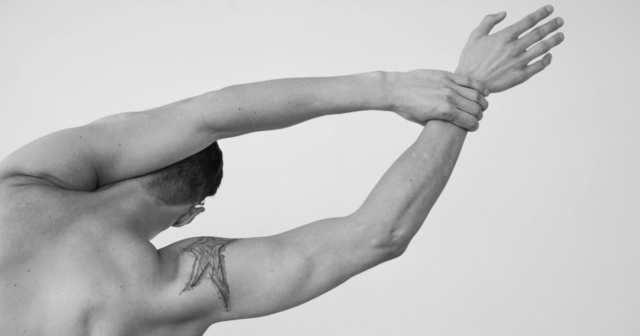Shoulder tension can creep up on you when you least expect it. Whether you’re hunched over a desk, carrying heavy bags, or simply stressed out, your shoulders tend to bear the brunt. But don’t worry, there are simple and effective ways to relieve this tension. In this blog post, we’ll explore a series of stretches, posture tips, and lifestyle adjustments that can help you keep your shoulders relaxed and pain-free.
Start Your Day with Stretching
Incorporating shoulder stretches into your daily routine can significantly improve flexibility and relieve tension. Here are four of my favourite stretches to keep your shoulders loose and relaxed:

Neck Rolls:
- Sit or stand tall and gently roll your neck in circles.
- Rotate clockwise for 1-2 minutes and then switch to counterclockwise for another 1-2 minutes.
- This helps release tension in the neck and shoulders.
Doorway Stretch:
- Stand in a doorway with your arms bent at 90 degrees and your forearms resting on the doorframe.
- Step forward, allowing your chest to stretch through the doorway, while keeping your arms and shoulders relaxed.
- Hold this stretch for 20-30 seconds.
- This stretch opens up your chest and shoulders, reducing tightness.
Eagle Arms:
- Sit or stand tall and bring your right arm under your left arm, crossing at the elbows.
- Press your palms together, or if possible, entwine your forearms and bring your palms to touch.
- Lift your elbows to shoulder height and draw your shoulder blades down and away from your ears.
- Hold for 20-30 seconds, then switch sides.
- This stretch targets the upper back and shoulders, alleviating tightness.
Levator Scapulae Stretch:
- Sit or stand tall and tilt your left ear toward your left shoulder.
- Place your left hand on the top of your head and gently pull your head towards your left shoulder.
- Feel a stretch in the right side of your neck and shoulder.
- Hold for 20-30 seconds, then switch sides.
- This stretch targets the neck and upper shoulders, helping to reduce stiffness.
Pay Attention to Your Posture
Good posture is essential in preventing shoulder strain, especially if you spend long hours sitting or working at a desk. Here are some tips:

Posture Awareness:
- Sit up straight and engage your core muscles.
- Avoid slouching to prevent unnecessary strain on your shoulders.
Ergonomic Setup:
- Ensure your workstation is ergonomically designed.
- Adjust your chair height, desk height, and computer monitor position to promote proper alignment.
- This reduces stress on your shoulders and back.
Take Breaks:
- If your activities involve repetitive shoulder movements, like typing or lifting, take frequent breaks.
- Allow your shoulders to rest and relax to avoid overuse and muscle fatigue.
Incorporate Heat Therapy
Applying heat to your shoulders can help relax muscles, improve blood flow, and relieve tension. Here’s how you can do it:
Heat Therapy:
- Use a heating pad, warm towel, or take a hot shower.
- Apply heat to the shoulders for about 15-20 minutes to ease discomfort.
Strengthen Your Shoulders
Strengthening exercises are crucial in improving shoulder stability and preventing tightness. Include these exercises in your fitness routine:
Strengthening Exercises:
- Dumbbell Lateral Raises: Hold a dumbbell in each hand, lift your arms to the side until they are at shoulder height, then lower them back down. Repeat 10-15 times.
- External Rotations: Hold a dumbbell in each hand, bend your elbows at 90 degrees, and rotate your arms outward. Repeat 10-15 times.
- Rows: Using a resistance band or dumbbells, pull your elbows back, squeezing your shoulder blades together. Repeat 10-15 times.
Manage Stress Effectively
High stress levels can contribute to muscle tension in the shoulders. Here are some relaxation techniques:
Stress Management:
- Practice deep breathing exercises to calm your mind and body.
- Engage in meditation or yoga to help reduce stress and tension in the shoulders.
Try Massage or Trigger Point Release
Massage or using a foam roller can release trigger points or knots in the shoulder muscles. Here’s how to do it:

Massage or Trigger Point Release:
- Consider getting a professional massage or use a foam roller to gently massage tight muscles.
- Focus on areas that feel tight or sore to help relax the muscles and alleviate discomfort.
Final Thoughts
Shoulder tension can be a daily nuisance, but with these simple tips and exercises, you can keep your shoulders relaxed and pain-free. Incorporate stretching, maintain good posture, use heat therapy, strengthen your shoulders, manage stress, and consider massage for comprehensive shoulder care. By making these small adjustments, you can significantly improve your shoulder health and overall well-being.




